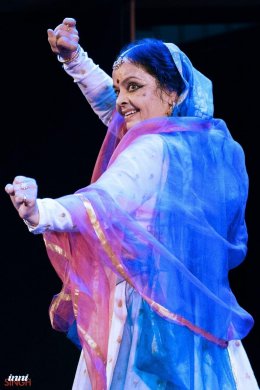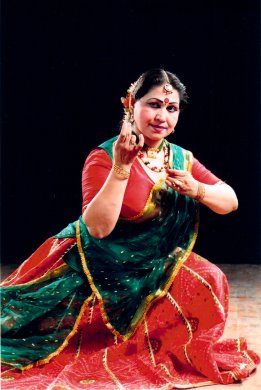
|   |

|   |
 e-mail: leelakaverivenkat@gmail.com Swing from ridiculous to sublime during homage to Guru Kundanlal Gangani August 9, 2018 See-sawing between dismay and ecstasy while watching the annual Guru Purnima homage Gurave Namah at Stein auditorium, Delhi, by the Guru Kundanlal Gangani Sangeet Akademi to the late Guru of the Jaipur gharana, one wondered at the present state of Kathak. Watching Neelakshi Khandakar Saxena and Divya Ghokale dancing tala Dhamar, followed by a composition on Sawan, became an exercise in futility with the tabla sounds so aggressively loud, that Vinod Gangani's singing for Sawan went totally unheard. One of the duo had the habit of constantly compressing her lips, showing a self consciousness which distracted the viewer. Equally disappointing was the second male/female duet with Sameeksha Sharma and Mahendra Parihar, who after the teentaal nritta followed with a portrayal of the abhisarika nayika. Several vexing questions dogged my mind. Does all of Kathak have to be only showmanship with skill? Where was the element of aesthetics? In all this virtuosity, I frankly detected some technical correctness but very little beauty. And the sadness is that I knew that every dancer who participated was a committed practitioner sparing no effort. It seemed as if they had been trained to think of only virtuosity as performance requirement. The composing of the abhisarika piece comprised several hackneyed individual images which never came together as an integrated concept. The nayika noting the moonlit night, the chirping birds, setting off to meet her beloved, the slight stepping back at a snake (?) and then lo and behold, the nayak arrives. Imagining the nayak's arrival or anticipation of meeting is what good abhinaya is about. With nayak suddenly appearing (absolutely expressionless) the element of suggestion, so important in interpretative dance, is lost with the two dancing together. With Mohit Gangani on tabla and Ashish Gangani on pakhawaj playing together in full blast, the tonal play of bols got lost. As for Yogesh Gangani who is such a talented player and a scion of the Kundanlal Gangani family, much in demand by Kathak dancers of the day, one wishes he could treat the tabla with more gentleness to increase its music. The smallest sound on this instrument can be heard. As for Sammiullah Khan who is also a very professionally certified Hindustani classical singer, the Yaman he sang seemed to be all in one note without any deep involvement. Does Kathak have no soft and delicate notes? Watching Anuradha Thakur one felt reassured. She began with the typical Rajasthani invocation to Shiva "Rangela Shambhu..." who has Nandi as his vehicle and Ganapati his son. The nritta in teentaal with Quayeda through its stages of unfolding with inner variations to the final flourish, excellent paran, amad, tihai, Ganapati kavit and one nritta composition with meend were very neatly executed. The short thumri finale with the ched/chad had its moments but towards the end became somewhat loud. Anuradha would be well advised to have her costume in one colour, without breaking up the body with the dupatta in a contrasting shade, which would give her figure a greater appearance of height, it can do with. Vidyagauri Adkar and Mujaffar Mulla as a duo began with tala Ashtamangal (11 matras), with a neat upaj and parmelu with the final paran becoming a well conceived composition for a male/female duet with the right hand of the male dancer as Shiva and left of the female showing Parvati. For a Guru Purnima presentation the conclusion with the hands held in the form of a lamp offered to the Guru in homage with the Gurur Brahma, Gurur Vishnu... hymn, was fitting. Far away from all this virtuosity, the concluding session on both evenings provided some of the most elevating moments of Kathak. Tastefully turned out, Prerana Shrimali's supremely aesthetic recital proved how Kathak can communicate with the most subtle of gestures, expressions and rhythm. Concentrating on just the nagma and what one wove into it (one of the very precious concerns of her Guru Kundan Lal Gangani) the tabla played to the nagma by one of the Guru's sons Fateh Singh Gangani was sheer music and he showed that rhythm without tonal musicality had no meaning. Prerana's thata was a statement in subtlety and minimalism- just a slightest tilt of the head and even a glance of the eye registering the ‘sama'. Ganesh Paran, Kundanlal Gangani's Paran with the gat, were rare examples and the dancer treated each bandish with delicacy in presentation, which was like a whisper communicating intimately with the viewer's inside. The equally understated abhinaya part, also very different from the usual lyrics for interpretative expression in this dance form was inspired by two Malhar ki Kavita bandishes in a kind of jawab/sawal exchange attributed to a great musician and his beloved wife. Set to raga Madhuwanti, and sung melodiously by Sandeep Gangani, the first bandish is: "Mein ayoon tore mandir vaa Paiya paran dee mohe Man basiyan"  Prerana Shrimali ; Photo: Inni Singh The nayika goes seeking the nayak, saying that her heart's desire can be fulfilled only when her feet enter the temple of his home. And the answer comes: "Are more mandirava tora ahere Kahe dhare na charan more man basiyan." "Don't be hesitant for this mandir is yours, and I desire that too." Prerana's dance interpretation did not destroy the magic moment with loud dance. The peacock dance, the embrace, sitting on the swing - were hinted at, and the tenderness of love came out beautifully. Mohammad Ayub Khan on sarangi and Mahavir Gangani on pakhawaj gave the right support.  Urmila Nagar Everybody was eager to see the concluding recital by the seniormost Jaipur Gharana specialist Guru Urmila Nagar, now in her seventies and not part of the hustle bustle of the Kathak biradari. Never a part of the rat race in the performance scene, Urmila Nagar has always lived very much within herself, totally grounded in the old classicism of her style - unmoved and in a sense unconcerned by the features coming into contemporary Kathak. Based on a thorough grounding in Hindustani classical music, her Kathak is one of its kind. Her greatest compliment as a teacher in Kathak is seen in the way she has trained her two superbly talented sons. The older son, an expert tablist, is now in the United States. The younger Ujwal Nagar, a truly shining star, captured audience hearts with his delightfully melodious and classically rich singing, the Durbari Kanada glowing. Equally laudable was the relaxed ease with which he performed the parhant, which when recited the right away provides tonal music. Urmila Nagar just had to whisper a bandish or mukda and the youngster needed no other cues. Urmila's footwork, in its lightest form in the 17 matra tala set to the lahra (musical refrain) spoke of a masterly sense of time, the fractional intervals expressed with such biting clarity. Sur just went on and on, the tala extensions flowing like a raga. The feet in kunchita, anchita or the way one foot was raised and brought to the front in a step was a lesson to see for all dancers. One was hoping for some real abhinaya which this dancer does with relish. But barring closing her eyes and enjoying both the Brindavan Saranga part and the final bit in Bhairavi, she refrained from doing any abhinaya. But for all Kathak lovers, watching the two senior dancers was a pleasure. The tablist was Fateh Singh Gangani.  Writing on the dance scene for the last forty years, Leela Venkataraman's incisive comments on performances of all dance forms, participation in dance discussions both in India and abroad, and as a regular contributor to Hindu Friday Review, journals like Sruti and Nartanam, makes her voice respected for its balanced critiquing. She is the author of several books like Indian Classical dance: Tradition in Transition, Classical Dance in India and Indian Classical dance: The Renaissance and Beyond. Post your comments Please provide your name and email id when you use the Anonymous profile in the blog to post a comment. All appropriate comments posted with name & email id in the blog will also be featured in the site. |